"RELATIONAL ROUTES": THE LATIN AMERICAN COLLECTIVE EXHIBITION AT LUCÍA MENDOZA
Rutas relacionales (Relational Routes) is the long-term collective with which the Lucía Mendoza gallery celebrates its tenth anniversary and with which it intends to raise awareness, through the work of about 40 artists, about several of the current thematic and philosophical axes, those that trace their need from the relationship of mankind with its environment. In these axes, we find lines of argument that deal with ecology, society and economies, passing through everything that composes them, such as political processes or the construction of identity.
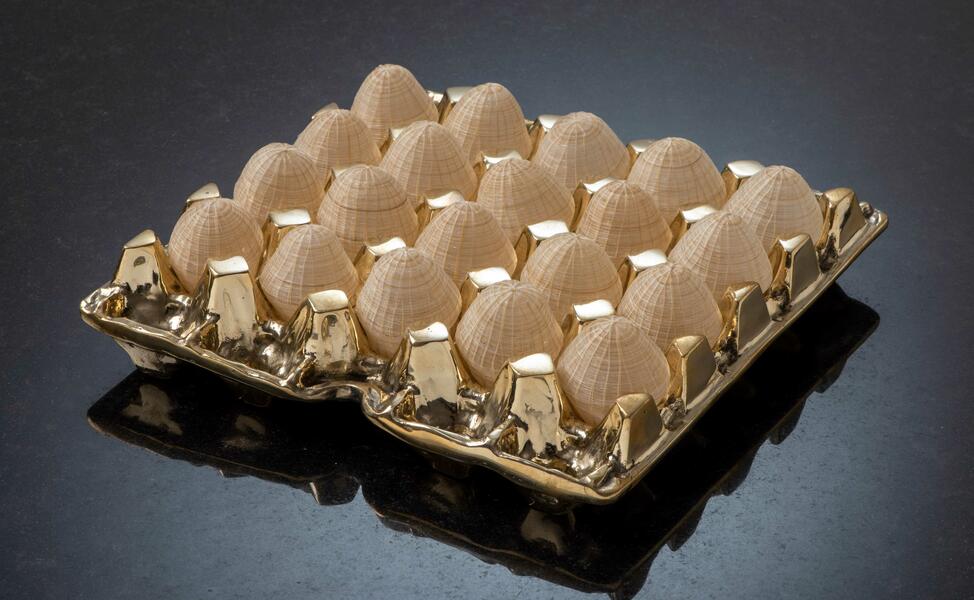
This exhibition also aims to be a collective project that encourages us to rethink the art ecosystem, from the physical and spatial structure of the gallery itself to the analysis of each of the subjects, active or passive, that make it up. To this end, Javier Martin-Jimenez, curator of the show, will be proposing different lines throughout these months, replacing the works periodically to propose as many dialogues as possible, something that can also be seen in the programming of activities and actions in the gallery around this exhibition and that contain a clear vocation to create those conversations.
In this first arrangement, the Latin American artists Amanda Legórburu (Caracas, Venezuela, 2000), who, with her intervention on a tapestry in Quema de ídolos, rethinks the traditional imaginary; Fritzia Irizar (Culiacan, Mexico, 1977), who continues her research on the value of money and questions the system that sustains it; Josefina Guilisasti (Santiago de Chile, Chile, 1963), who works with the idea of the environment as a revalorizer in the art world through decontextualized everyday objects.
-
Fritzia Irizar_Sin título (ISO 4217)_2017_papel reciclado a mano y tinta hecha con cenizas de papel de moneda_27,9 x 21,5 cm_detalle poema. Foto. Álvaro Oliveros
-
Amanda Legórburu_Jenny Marketou_obra en sala. Foto. Álvaro Oliveros
-
Amanda Legórburu_Quema de ídolos_2024_Bordado y carboncillo sobre tapiz_170 x 183 cm. Foto. Álvaro Oliveros
-
Amanda Legórburu_Quema de ídolos_2024_tapiz intervenido con bordado y carboncillo_170 x 183 cm_detalle. © Álvaro Oliveros
-
Fritzia Irizar_Josefina Guilisasti_obra en sala_vista fronta. Foto. Álvaro Oliveros
-
Fritzia Irizar_Sin título (ISO 4217)_2017_papel reciclado a mano y tinta hecha con cenizas de papel de moneda_27,9 x 21,5 cm_detalle poema. Foto. Álvaro Oliveros
-
Fritzia Irizar_Sin título (quema de dólares)_2017_vídeo. Foto. Álvaro Oliveros
-
Josefina Guilisasti_Objetos Cotidianos_2023_caja de cartón con huevos de pelo de caballo_30 x 30 x 8 cm. Foto. Álvaro Oliveros
-
Josefina Guilisasti_Objetos Cotidianos_2023_detalle huevos crin. Foto. Álvaro Oliveros
-
Josefina Guilisasti_Objetos Cotidianos_2023_porcelana, vidrio, crin de caballo, bronce y cartón_medidas variables. Foto. Álvaro Oliveros
-
Josefina Guilisasti_Serie Objetos Cotidianos_2023_medidas y materiales variables. Foto. Álvaro Oliveros
-
Josefina Guilisasti. Pieza en bronce y huevos en crin. 2023. 28 x 28 x 5 cm(1)
Rutas relacionales can be seen until July 2025 at Lucía Mendoza, calle de Bárbara de Braganza, 10, Madrid (Spain).
May interest you
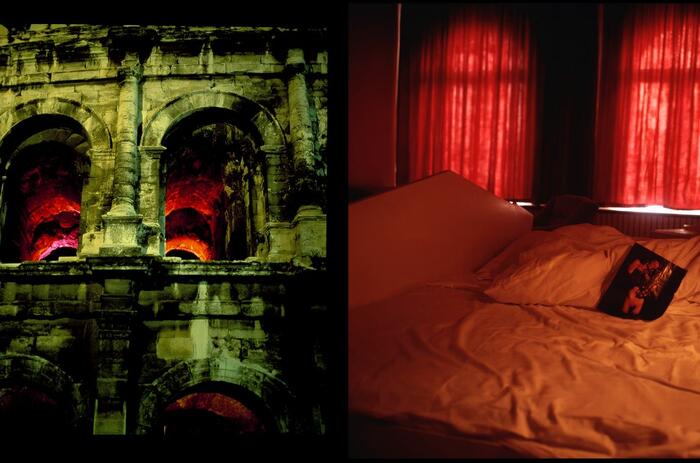
The Niemeyer Center, in the Asturian city of Aviles, hosts Tokyo Blues hacia Gritos Sordos (From Tokyo Blues to Deaf Cries), an exhibition by Brazilian photographer Miguel Rio Branco (Las Palmas de Gran Canaria, Spain, 1946) that traces a journey through his work of crossed images and pieces that were conceived from his personal experience on a trip to Japan, a country whose culture and names in cinema, art and architecture have always fascinated the artist.
RIO BRANCO'S JAPANESE FASCINATION IN AVILÉS
The Niemeyer Center, in the Asturian city of Aviles, hosts Tokyo Blues hacia Gritos Sordos (From Tokyo Blues to Deaf Cries), an exhibition by Brazilian photographer Miguel Rio Branco (Las Palmas de Gran Canaria, Spain, 1946) that traces a journey through his work of crossed images and pieces that were conceived from his personal experience on a trip to Japan, a country whose culture and names in cinema, art and architecture have always fascinated the artist.

The Niemeyer Center, in the Asturian city of Aviles, hosts Tokyo Blues hacia Gritos Sordos (From Tokyo Blues to Deaf Cries), an exhibition by Brazilian photographer Miguel Rio Branco (Las Palmas de Gran Canaria, Spain, 1946) that traces a journey through his work of crossed images and pieces that were conceived from his personal experience on a trip to Japan, a country whose culture and names in cinema, art and architecture have always fascinated the artist.
RIO BRANCO'S JAPANESE FASCINATION IN AVILÉS
The Niemeyer Center, in the Asturian city of Aviles, hosts Tokyo Blues hacia Gritos Sordos (From Tokyo Blues to Deaf Cries), an exhibition by Brazilian photographer Miguel Rio Branco (Las Palmas de Gran Canaria, Spain, 1946) that traces a journey through his work of crossed images and pieces that were conceived from his personal experience on a trip to Japan, a country whose culture and names in cinema, art and architecture have always fascinated the artist.
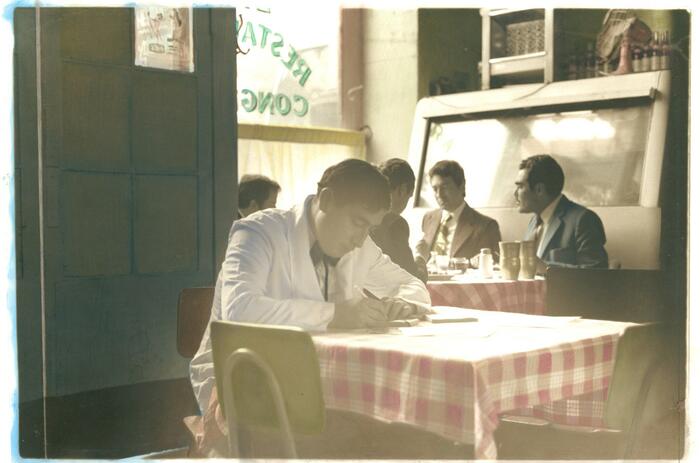
Larivière Foundation opens two exhibitions: Ideas Fijas (Fixed Ideas), by Cecilia Szalkowicz, curated by Mariano Mayer; and Carrusel de melancolías (Carousel of Melancholy), by renowned Chilean photographer Leonora Vicuña, curated by Alexis Fabry.
TWO EXHIBITIONS, TWO WOMEN PHOTOGRAPHERS AT THE LARIVÈRE FOUNDATION
Larivière Foundation opens two exhibitions: Ideas Fijas (Fixed Ideas), by Cecilia Szalkowicz, curated by Mariano Mayer; and Carrusel de melancolías (Carousel of Melancholy), by renowned Chilean photographer Leonora Vicuña, curated by Alexis Fabry.
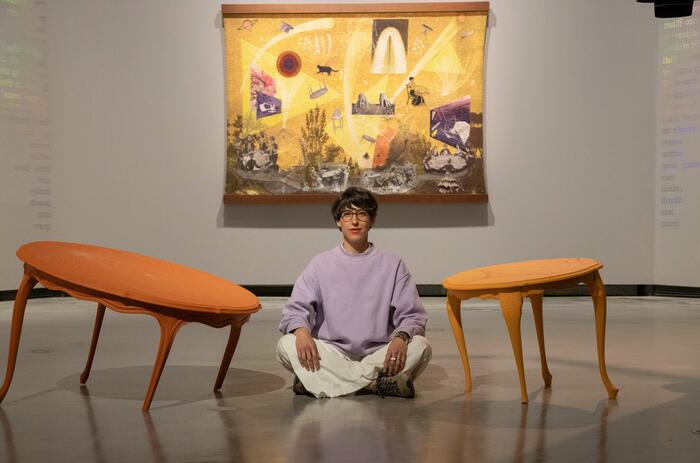
Mercedes Azpilicueta (La Plata, Argentina, 1981) lands with her dancing tables at the Centro de Creación Contemporánea de Andalucía (C3A) in an exhibition curated by Verónica Rossi and Jimena Blázquez. A visual and performance artist based in Amsterdam, her artistic practice proposes in her multi-layered works a meeting place between the past and the present through her protagonists and their expressions, some physical -but not corporeal-, such as voices; others, material, such as forms and texts; and others of a more intangible nature such as memory and remembrance.
MERCEDES AZPILICUETA AND HER “DANCING TABLES” IN C3A
Mercedes Azpilicueta (La Plata, Argentina, 1981) lands with her dancing tables at the Centro de Creación Contemporánea de Andalucía (C3A) in an exhibition curated by Verónica Rossi and Jimena Blázquez. A visual and performance artist based in Amsterdam, her artistic practice proposes in her multi-layered works a meeting place between the past and the present through her protagonists and their expressions, some physical -but not corporeal-, such as voices; others, material, such as forms and texts; and others of a more intangible nature such as memory and remembrance.
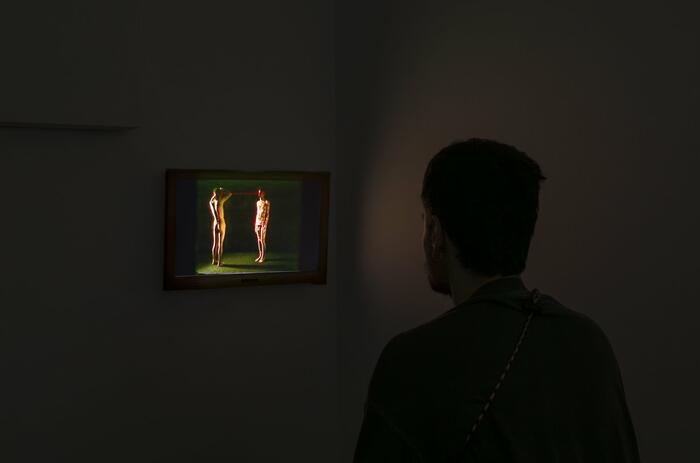
Zielinsky presents in its Barcelona space Gladiators of the future, a solo exhibition by Claudio Goulart (Brazil, 1954 - The Netherlands, 2005) that continues Fragmentos da Memória, the exhibition on Goulart held at the gallery's headquarters in São Paulo. The show addresses themes of politics, the body and time, the usual axes of the Brazilian's production, which relied on his life experience as the main source.
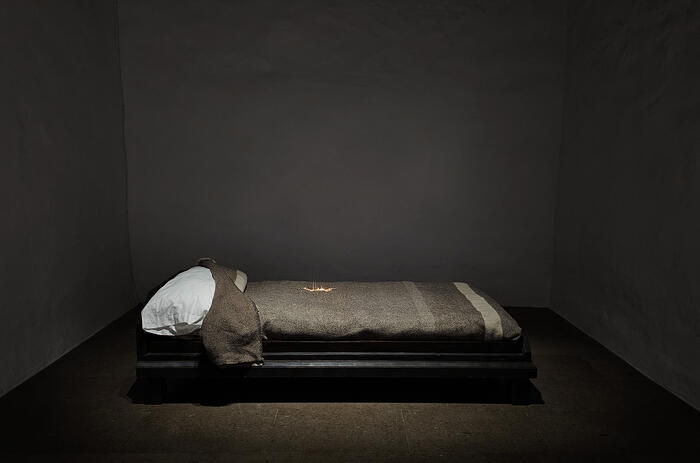
Pamen Pereira (Ferrol, Spain, 1963) unfolds her project Don't give up at Artizar gallery in Tenerife, a show made up of fourteen pieces that make up a total, but that must be seen from the prism of combination and language. However, the artist advocates for observing what is hidden behind the relationship of her works, the selection and the dialogue that the tour offers us.
PAMEN PEREIRA: SPACE, ORDER AND ELEMENTS, AT ARTIZAR
Pamen Pereira (Ferrol, Spain, 1963) unfolds her project Don't give up at Artizar gallery in Tenerife, a show made up of fourteen pieces that make up a total, but that must be seen from the prism of combination and language. However, the artist advocates for observing what is hidden behind the relationship of her works, the selection and the dialogue that the tour offers us.
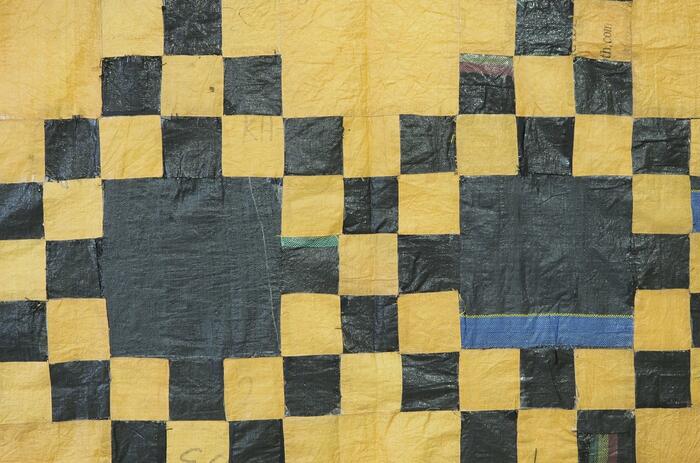
Casa de América is hosting three interconnected exhibitions in Madrid until November 30 that investigate and show the influence of the arts and the roots of pre-Columbian cultures in contemporary art and architecture.
THE PRE-COLUMBIAN ROOTS IN THE CONTEMPORARY, AT CASA DE AMERICA
Casa de América is hosting three interconnected exhibitions in Madrid until November 30 that investigate and show the influence of the arts and the roots of pre-Columbian cultures in contemporary art and architecture.
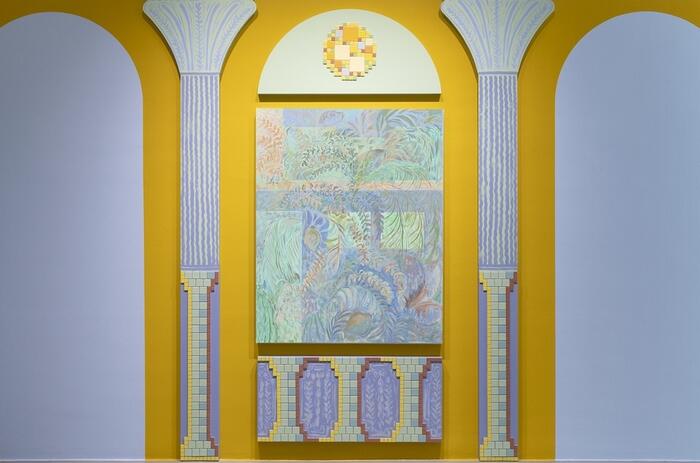
The gallery Lorena Ruiz de Villa hosts the exhibition Casa Encontrada, where the artist Sol Calero (Caracas, Venezuela, 1982) presents a new series of paintings that start from her previous work as a point of reference and in which she advocates the detachment of the most precise definition of her themes, with references to her origins. This proposal, however, leads us to a concept that walks on the line of the interrelation of the human and the natural, making his new production more fractionable.
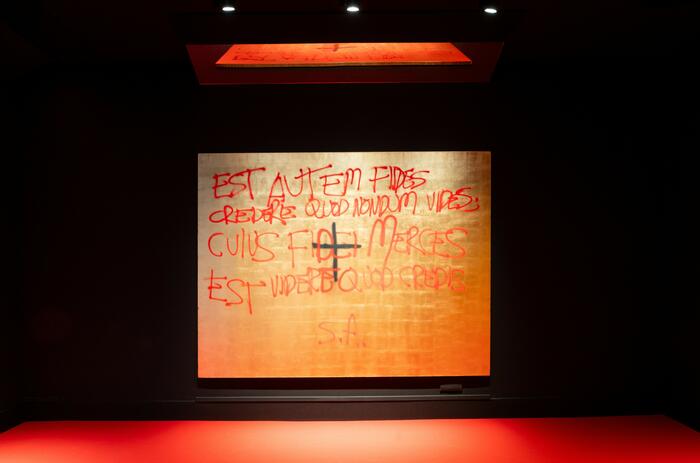
Stefan Brüggemann (Mexico City, Mexico, 1975) disembarks at Casa de México with Dos líneas (fe), a series that is understood as an installation and that starts from the impact and the apparent simplicity exposed to develop the concept of inheritance and its satellites. The Mexican conceptual artist uses the power reflected by symbols, religion and history, an element that he deploys, sometimes explicitly, in his large-format works.
STEFAN BRÜGGEMANN'S LINES OF FAITH, AT CASA DE MEXICO
Stefan Brüggemann (Mexico City, Mexico, 1975) disembarks at Casa de México with Dos líneas (fe), a series that is understood as an installation and that starts from the impact and the apparent simplicity exposed to develop the concept of inheritance and its satellites. The Mexican conceptual artist uses the power reflected by symbols, religion and history, an element that he deploys, sometimes explicitly, in his large-format works.
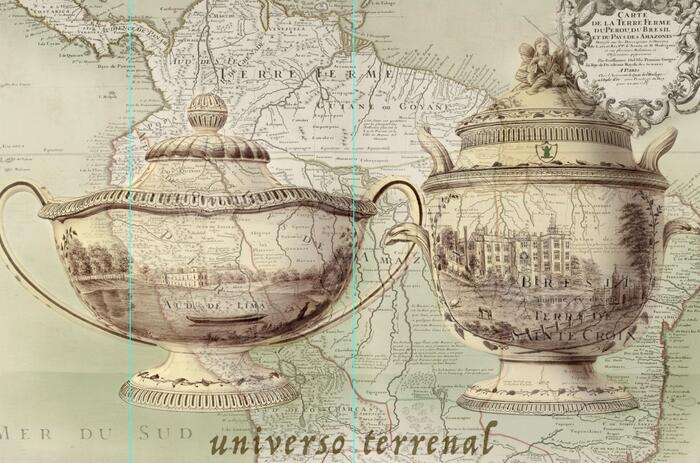
From her different interdisciplinary perspectives, Cecilia Paredes (Lima, Peru, 1950) lands in Blanca Berlin with a collection of images that deal with imaginary cartographies, displacements and human relations in their conceptual part, materialized, above all, on canvas as the main exhibition material. In Historias errantes (Wandering Stories), the Peruvian artist bets on recovering graphic materials anchored in antiquity, such as astrological charts, engravings of discoveries and maps, which become, after the manipulation of the parts, absolute compositions of impossible -but also aesthetic- iconography.
THE WANDERING STORIES OF CECILIA PAREDES, IN BLANCA BERLIN
From her different interdisciplinary perspectives, Cecilia Paredes (Lima, Peru, 1950) lands in Blanca Berlin with a collection of images that deal with imaginary cartographies, displacements and human relations in their conceptual part, materialized, above all, on canvas as the main exhibition material. In Historias errantes (Wandering Stories), the Peruvian artist bets on recovering graphic materials anchored in antiquity, such as astrological charts, engravings of discoveries and maps, which become, after the manipulation of the parts, absolute compositions of impossible -but also aesthetic- iconography.
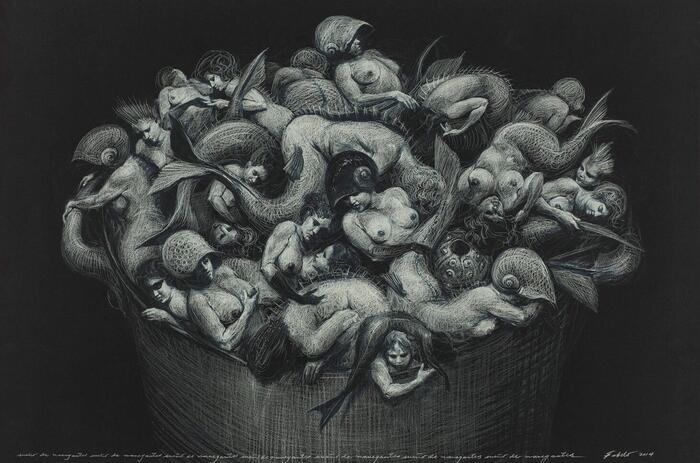
The DA2 hosts the last stage of the itinerancy of the Luciano Méndez Sánchez Contemporary Cuban Art Collection, a cycle of exhibitions that the collection started in 2019 in Spain in this institution and that reflects, through different curatorial lines, the realities and attitudes around contemporary art in Cuba.
THE LATEST TOUR AT DA2 OF THE LUCIANO MÉNDEZ SÁNCHEZ CONTEMPORARY CUBAN ART COLLECTION
The DA2 hosts the last stage of the itinerancy of the Luciano Méndez Sánchez Contemporary Cuban Art Collection, a cycle of exhibitions that the collection started in 2019 in Spain in this institution and that reflects, through different curatorial lines, the realities and attitudes around contemporary art in Cuba.
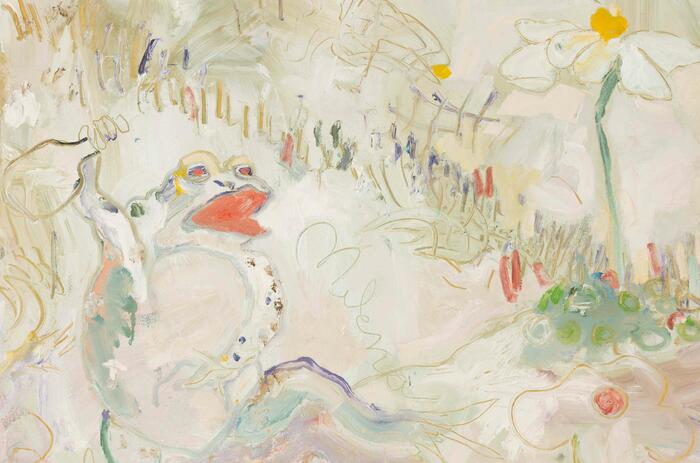
Travesía Cuatro hosts at its Madrid headquarters Surf and Turf, the fifth exhibition that the gallery dedicates to Milena Múzquiz (Tijuana, Mexico, 1972), that gathers, with about thirty works, the continuity of the production that began after the aesthetic and technical change produced by the end of Los Súper Elegantes, a musical group that he shared with the Argentine Martiniano López Crozet, and which represented a platform that brought together his purest expression through voice and body, as well as with the aesthetic possibilities of costumes and image.
THE DAILY LIFE AND POPULAR EXPRESSION OF MILENA MÚZQUIZ IN TRAVESÍA CUATRO
Travesía Cuatro hosts at its Madrid headquarters Surf and Turf, the fifth exhibition that the gallery dedicates to Milena Múzquiz (Tijuana, Mexico, 1972), that gathers, with about thirty works, the continuity of the production that began after the aesthetic and technical change produced by the end of Los Súper Elegantes, a musical group that he shared with the Argentine Martiniano López Crozet, and which represented a platform that brought together his purest expression through voice and body, as well as with the aesthetic possibilities of costumes and image.
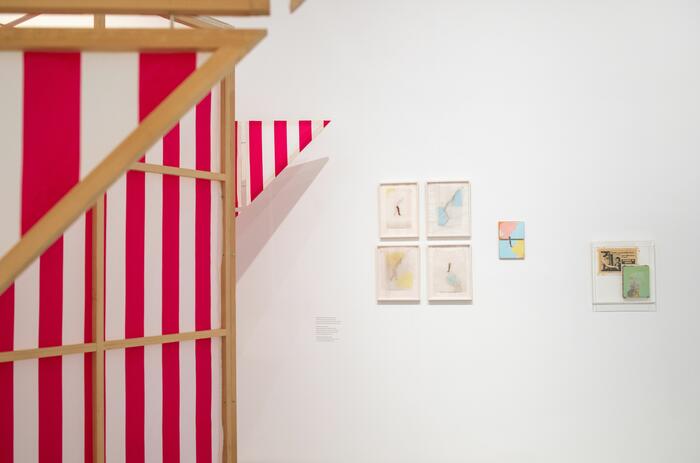
“I imagine the museum as an archipelago. It is not a continent, but an archipelago (...) The idea today is to put the world in contact with the world, to put some parts of the world in contact with other parts of the world... We must multiply the number of worlds inside museums”. Édouard Glissant (Sainte-Marie, Martinique, 1929-Paris, France, 2011) expressed his vision of museum functionality in this metaphorical way in his work Poetics of Relationship (1990).
CAN THE ARCHIPELAGO ENTER THE MUSEUM? IBEROAMERICA IN THE PROPOSAL OF THE HELGA DE ALVEAR MUSEUM
“I imagine the museum as an archipelago. It is not a continent, but an archipelago (...) The idea today is to put the world in contact with the world, to put some parts of the world in contact with other parts of the world... We must multiply the number of worlds inside museums”. Édouard Glissant (Sainte-Marie, Martinique, 1929-Paris, France, 2011) expressed his vision of museum functionality in this metaphorical way in his work Poetics of Relationship (1990).
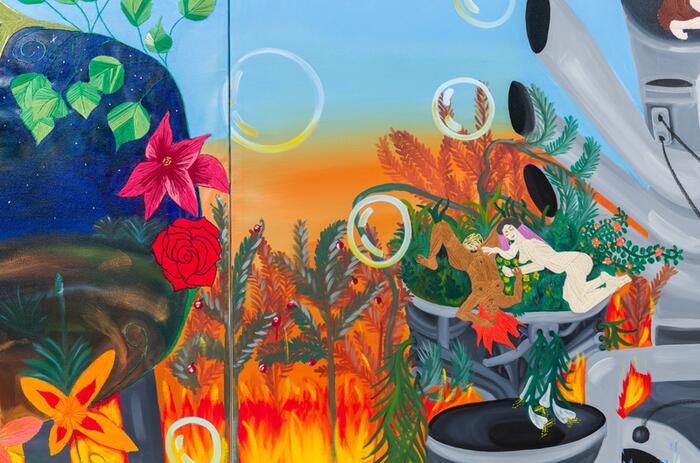
Siluetas sobre maleza [Silhouettes on grass] is a group exhibition at Museo Jumex that explores the ways in which bodies exist and inhabit territory. Spanning several generations, the exhibition features artists who explore the intertwined associations of body, land and identity in Latin America's history and present: Minia Biabiany (Guadalupe, 1988), Vivian Caccuri (Brazil, 1986), Frieda Toranzo Jaeger (Mexico, 1988), Ana Mendieta (Cuba, 1948 - USA, 1985), Nohemí Pérez (Colombia, 1962) and Vivian Suter (Argentina, 1949).
BODIES & TERRITORY: A GROUP EXHIBITION AT JUMEX MUSEUM
Siluetas sobre maleza [Silhouettes on grass] is a group exhibition at Museo Jumex that explores the ways in which bodies exist and inhabit territory. Spanning several generations, the exhibition features artists who explore the intertwined associations of body, land and identity in Latin America's history and present: Minia Biabiany (Guadalupe, 1988), Vivian Caccuri (Brazil, 1986), Frieda Toranzo Jaeger (Mexico, 1988), Ana Mendieta (Cuba, 1948 - USA, 1985), Nohemí Pérez (Colombia, 1962) and Vivian Suter (Argentina, 1949).
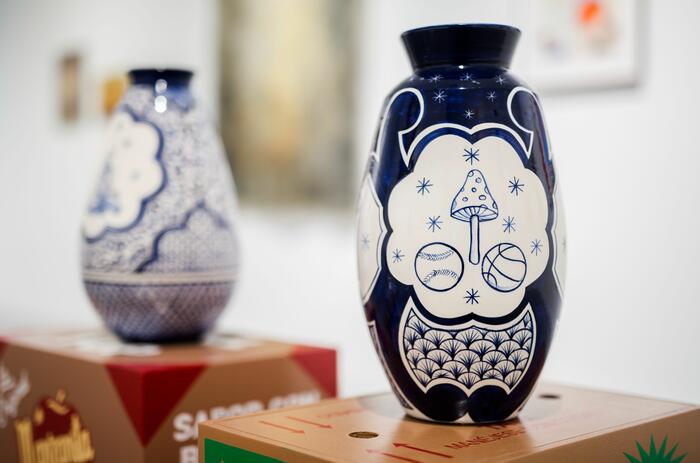
In an art industry that increasingly advocates following the lines established by cultural policies, it is always comforting to return to thesis themes, to environments that draw from social and historiographic sources, of course, but also from myths and a well-understood anthropology. You can go deeper in subtitles and lines or you can put together a skeleton, but the overview can also be a reward these days.
THE FIRE KEEPERS, A PERSPECTIVE ON THE MYTH OF FIRE FROM A MEXICAN CURATORIAL PERSPECTIVE
In an art industry that increasingly advocates following the lines established by cultural policies, it is always comforting to return to thesis themes, to environments that draw from social and historiographic sources, of course, but also from myths and a well-understood anthropology. You can go deeper in subtitles and lines or you can put together a skeleton, but the overview can also be a reward these days.

The Niemeyer Center, in the Asturian city of Aviles, hosts Tokyo Blues hacia Gritos Sordos (From Tokyo Blues to Deaf Cries), an exhibition by Brazilian photographer Miguel Rio Branco (Las Palmas de Gran Canaria, Spain, 1946) that traces a journey through his work of crossed images and pieces that were conceived from his personal experience on a trip to Japan, a country whose culture and names in cinema, art and architecture have always fascinated the artist.
RIO BRANCO'S JAPANESE FASCINATION IN AVILÉS
The Niemeyer Center, in the Asturian city of Aviles, hosts Tokyo Blues hacia Gritos Sordos (From Tokyo Blues to Deaf Cries), an exhibition by Brazilian photographer Miguel Rio Branco (Las Palmas de Gran Canaria, Spain, 1946) that traces a journey through his work of crossed images and pieces that were conceived from his personal experience on a trip to Japan, a country whose culture and names in cinema, art and architecture have always fascinated the artist.

Larivière Foundation opens two exhibitions: Ideas Fijas (Fixed Ideas), by Cecilia Szalkowicz, curated by Mariano Mayer; and Carrusel de melancolías (Carousel of Melancholy), by renowned Chilean photographer Leonora Vicuña, curated by Alexis Fabry.
TWO EXHIBITIONS, TWO WOMEN PHOTOGRAPHERS AT THE LARIVÈRE FOUNDATION
Larivière Foundation opens two exhibitions: Ideas Fijas (Fixed Ideas), by Cecilia Szalkowicz, curated by Mariano Mayer; and Carrusel de melancolías (Carousel of Melancholy), by renowned Chilean photographer Leonora Vicuña, curated by Alexis Fabry.

Mercedes Azpilicueta (La Plata, Argentina, 1981) lands with her dancing tables at the Centro de Creación Contemporánea de Andalucía (C3A) in an exhibition curated by Verónica Rossi and Jimena Blázquez. A visual and performance artist based in Amsterdam, her artistic practice proposes in her multi-layered works a meeting place between the past and the present through her protagonists and their expressions, some physical -but not corporeal-, such as voices; others, material, such as forms and texts; and others of a more intangible nature such as memory and remembrance.
MERCEDES AZPILICUETA AND HER “DANCING TABLES” IN C3A
Mercedes Azpilicueta (La Plata, Argentina, 1981) lands with her dancing tables at the Centro de Creación Contemporánea de Andalucía (C3A) in an exhibition curated by Verónica Rossi and Jimena Blázquez. A visual and performance artist based in Amsterdam, her artistic practice proposes in her multi-layered works a meeting place between the past and the present through her protagonists and their expressions, some physical -but not corporeal-, such as voices; others, material, such as forms and texts; and others of a more intangible nature such as memory and remembrance.

Zielinsky presents in its Barcelona space Gladiators of the future, a solo exhibition by Claudio Goulart (Brazil, 1954 - The Netherlands, 2005) that continues Fragmentos da Memória, the exhibition on Goulart held at the gallery's headquarters in São Paulo. The show addresses themes of politics, the body and time, the usual axes of the Brazilian's production, which relied on his life experience as the main source.

Pamen Pereira (Ferrol, Spain, 1963) unfolds her project Don't give up at Artizar gallery in Tenerife, a show made up of fourteen pieces that make up a total, but that must be seen from the prism of combination and language. However, the artist advocates for observing what is hidden behind the relationship of her works, the selection and the dialogue that the tour offers us.
PAMEN PEREIRA: SPACE, ORDER AND ELEMENTS, AT ARTIZAR
Pamen Pereira (Ferrol, Spain, 1963) unfolds her project Don't give up at Artizar gallery in Tenerife, a show made up of fourteen pieces that make up a total, but that must be seen from the prism of combination and language. However, the artist advocates for observing what is hidden behind the relationship of her works, the selection and the dialogue that the tour offers us.

Casa de América is hosting three interconnected exhibitions in Madrid until November 30 that investigate and show the influence of the arts and the roots of pre-Columbian cultures in contemporary art and architecture.
THE PRE-COLUMBIAN ROOTS IN THE CONTEMPORARY, AT CASA DE AMERICA
Casa de América is hosting three interconnected exhibitions in Madrid until November 30 that investigate and show the influence of the arts and the roots of pre-Columbian cultures in contemporary art and architecture.

The gallery Lorena Ruiz de Villa hosts the exhibition Casa Encontrada, where the artist Sol Calero (Caracas, Venezuela, 1982) presents a new series of paintings that start from her previous work as a point of reference and in which she advocates the detachment of the most precise definition of her themes, with references to her origins. This proposal, however, leads us to a concept that walks on the line of the interrelation of the human and the natural, making his new production more fractionable.

Stefan Brüggemann (Mexico City, Mexico, 1975) disembarks at Casa de México with Dos líneas (fe), a series that is understood as an installation and that starts from the impact and the apparent simplicity exposed to develop the concept of inheritance and its satellites. The Mexican conceptual artist uses the power reflected by symbols, religion and history, an element that he deploys, sometimes explicitly, in his large-format works.
STEFAN BRÜGGEMANN'S LINES OF FAITH, AT CASA DE MEXICO
Stefan Brüggemann (Mexico City, Mexico, 1975) disembarks at Casa de México with Dos líneas (fe), a series that is understood as an installation and that starts from the impact and the apparent simplicity exposed to develop the concept of inheritance and its satellites. The Mexican conceptual artist uses the power reflected by symbols, religion and history, an element that he deploys, sometimes explicitly, in his large-format works.

From her different interdisciplinary perspectives, Cecilia Paredes (Lima, Peru, 1950) lands in Blanca Berlin with a collection of images that deal with imaginary cartographies, displacements and human relations in their conceptual part, materialized, above all, on canvas as the main exhibition material. In Historias errantes (Wandering Stories), the Peruvian artist bets on recovering graphic materials anchored in antiquity, such as astrological charts, engravings of discoveries and maps, which become, after the manipulation of the parts, absolute compositions of impossible -but also aesthetic- iconography.
THE WANDERING STORIES OF CECILIA PAREDES, IN BLANCA BERLIN
From her different interdisciplinary perspectives, Cecilia Paredes (Lima, Peru, 1950) lands in Blanca Berlin with a collection of images that deal with imaginary cartographies, displacements and human relations in their conceptual part, materialized, above all, on canvas as the main exhibition material. In Historias errantes (Wandering Stories), the Peruvian artist bets on recovering graphic materials anchored in antiquity, such as astrological charts, engravings of discoveries and maps, which become, after the manipulation of the parts, absolute compositions of impossible -but also aesthetic- iconography.

The DA2 hosts the last stage of the itinerancy of the Luciano Méndez Sánchez Contemporary Cuban Art Collection, a cycle of exhibitions that the collection started in 2019 in Spain in this institution and that reflects, through different curatorial lines, the realities and attitudes around contemporary art in Cuba.
THE LATEST TOUR AT DA2 OF THE LUCIANO MÉNDEZ SÁNCHEZ CONTEMPORARY CUBAN ART COLLECTION
The DA2 hosts the last stage of the itinerancy of the Luciano Méndez Sánchez Contemporary Cuban Art Collection, a cycle of exhibitions that the collection started in 2019 in Spain in this institution and that reflects, through different curatorial lines, the realities and attitudes around contemporary art in Cuba.

Travesía Cuatro hosts at its Madrid headquarters Surf and Turf, the fifth exhibition that the gallery dedicates to Milena Múzquiz (Tijuana, Mexico, 1972), that gathers, with about thirty works, the continuity of the production that began after the aesthetic and technical change produced by the end of Los Súper Elegantes, a musical group that he shared with the Argentine Martiniano López Crozet, and which represented a platform that brought together his purest expression through voice and body, as well as with the aesthetic possibilities of costumes and image.
THE DAILY LIFE AND POPULAR EXPRESSION OF MILENA MÚZQUIZ IN TRAVESÍA CUATRO
Travesía Cuatro hosts at its Madrid headquarters Surf and Turf, the fifth exhibition that the gallery dedicates to Milena Múzquiz (Tijuana, Mexico, 1972), that gathers, with about thirty works, the continuity of the production that began after the aesthetic and technical change produced by the end of Los Súper Elegantes, a musical group that he shared with the Argentine Martiniano López Crozet, and which represented a platform that brought together his purest expression through voice and body, as well as with the aesthetic possibilities of costumes and image.

“I imagine the museum as an archipelago. It is not a continent, but an archipelago (...) The idea today is to put the world in contact with the world, to put some parts of the world in contact with other parts of the world... We must multiply the number of worlds inside museums”. Édouard Glissant (Sainte-Marie, Martinique, 1929-Paris, France, 2011) expressed his vision of museum functionality in this metaphorical way in his work Poetics of Relationship (1990).
CAN THE ARCHIPELAGO ENTER THE MUSEUM? IBEROAMERICA IN THE PROPOSAL OF THE HELGA DE ALVEAR MUSEUM
“I imagine the museum as an archipelago. It is not a continent, but an archipelago (...) The idea today is to put the world in contact with the world, to put some parts of the world in contact with other parts of the world... We must multiply the number of worlds inside museums”. Édouard Glissant (Sainte-Marie, Martinique, 1929-Paris, France, 2011) expressed his vision of museum functionality in this metaphorical way in his work Poetics of Relationship (1990).

Siluetas sobre maleza [Silhouettes on grass] is a group exhibition at Museo Jumex that explores the ways in which bodies exist and inhabit territory. Spanning several generations, the exhibition features artists who explore the intertwined associations of body, land and identity in Latin America's history and present: Minia Biabiany (Guadalupe, 1988), Vivian Caccuri (Brazil, 1986), Frieda Toranzo Jaeger (Mexico, 1988), Ana Mendieta (Cuba, 1948 - USA, 1985), Nohemí Pérez (Colombia, 1962) and Vivian Suter (Argentina, 1949).
BODIES & TERRITORY: A GROUP EXHIBITION AT JUMEX MUSEUM
Siluetas sobre maleza [Silhouettes on grass] is a group exhibition at Museo Jumex that explores the ways in which bodies exist and inhabit territory. Spanning several generations, the exhibition features artists who explore the intertwined associations of body, land and identity in Latin America's history and present: Minia Biabiany (Guadalupe, 1988), Vivian Caccuri (Brazil, 1986), Frieda Toranzo Jaeger (Mexico, 1988), Ana Mendieta (Cuba, 1948 - USA, 1985), Nohemí Pérez (Colombia, 1962) and Vivian Suter (Argentina, 1949).

In an art industry that increasingly advocates following the lines established by cultural policies, it is always comforting to return to thesis themes, to environments that draw from social and historiographic sources, of course, but also from myths and a well-understood anthropology. You can go deeper in subtitles and lines or you can put together a skeleton, but the overview can also be a reward these days.
THE FIRE KEEPERS, A PERSPECTIVE ON THE MYTH OF FIRE FROM A MEXICAN CURATORIAL PERSPECTIVE
In an art industry that increasingly advocates following the lines established by cultural policies, it is always comforting to return to thesis themes, to environments that draw from social and historiographic sources, of course, but also from myths and a well-understood anthropology. You can go deeper in subtitles and lines or you can put together a skeleton, but the overview can also be a reward these days.

The Niemeyer Center, in the Asturian city of Aviles, hosts Tokyo Blues hacia Gritos Sordos (From Tokyo Blues to Deaf Cries), an exhibition by Brazilian photographer Miguel Rio Branco (Las Palmas de Gran Canaria, Spain, 1946) that traces a journey through his work of crossed images and pieces that were conceived from his personal experience on a trip to Japan, a country whose culture and names in cinema, art and architecture have always fascinated the artist.
RIO BRANCO'S JAPANESE FASCINATION IN AVILÉS
The Niemeyer Center, in the Asturian city of Aviles, hosts Tokyo Blues hacia Gritos Sordos (From Tokyo Blues to Deaf Cries), an exhibition by Brazilian photographer Miguel Rio Branco (Las Palmas de Gran Canaria, Spain, 1946) that traces a journey through his work of crossed images and pieces that were conceived from his personal experience on a trip to Japan, a country whose culture and names in cinema, art and architecture have always fascinated the artist.

Larivière Foundation opens two exhibitions: Ideas Fijas (Fixed Ideas), by Cecilia Szalkowicz, curated by Mariano Mayer; and Carrusel de melancolías (Carousel of Melancholy), by renowned Chilean photographer Leonora Vicuña, curated by Alexis Fabry.
TWO EXHIBITIONS, TWO WOMEN PHOTOGRAPHERS AT THE LARIVÈRE FOUNDATION
Larivière Foundation opens two exhibitions: Ideas Fijas (Fixed Ideas), by Cecilia Szalkowicz, curated by Mariano Mayer; and Carrusel de melancolías (Carousel of Melancholy), by renowned Chilean photographer Leonora Vicuña, curated by Alexis Fabry.

Mercedes Azpilicueta (La Plata, Argentina, 1981) lands with her dancing tables at the Centro de Creación Contemporánea de Andalucía (C3A) in an exhibition curated by Verónica Rossi and Jimena Blázquez. A visual and performance artist based in Amsterdam, her artistic practice proposes in her multi-layered works a meeting place between the past and the present through her protagonists and their expressions, some physical -but not corporeal-, such as voices; others, material, such as forms and texts; and others of a more intangible nature such as memory and remembrance.
MERCEDES AZPILICUETA AND HER “DANCING TABLES” IN C3A
Mercedes Azpilicueta (La Plata, Argentina, 1981) lands with her dancing tables at the Centro de Creación Contemporánea de Andalucía (C3A) in an exhibition curated by Verónica Rossi and Jimena Blázquez. A visual and performance artist based in Amsterdam, her artistic practice proposes in her multi-layered works a meeting place between the past and the present through her protagonists and their expressions, some physical -but not corporeal-, such as voices; others, material, such as forms and texts; and others of a more intangible nature such as memory and remembrance.

Zielinsky presents in its Barcelona space Gladiators of the future, a solo exhibition by Claudio Goulart (Brazil, 1954 - The Netherlands, 2005) that continues Fragmentos da Memória, the exhibition on Goulart held at the gallery's headquarters in São Paulo. The show addresses themes of politics, the body and time, the usual axes of the Brazilian's production, which relied on his life experience as the main source.

Pamen Pereira (Ferrol, Spain, 1963) unfolds her project Don't give up at Artizar gallery in Tenerife, a show made up of fourteen pieces that make up a total, but that must be seen from the prism of combination and language. However, the artist advocates for observing what is hidden behind the relationship of her works, the selection and the dialogue that the tour offers us.
PAMEN PEREIRA: SPACE, ORDER AND ELEMENTS, AT ARTIZAR
Pamen Pereira (Ferrol, Spain, 1963) unfolds her project Don't give up at Artizar gallery in Tenerife, a show made up of fourteen pieces that make up a total, but that must be seen from the prism of combination and language. However, the artist advocates for observing what is hidden behind the relationship of her works, the selection and the dialogue that the tour offers us.

Casa de América is hosting three interconnected exhibitions in Madrid until November 30 that investigate and show the influence of the arts and the roots of pre-Columbian cultures in contemporary art and architecture.
THE PRE-COLUMBIAN ROOTS IN THE CONTEMPORARY, AT CASA DE AMERICA
Casa de América is hosting three interconnected exhibitions in Madrid until November 30 that investigate and show the influence of the arts and the roots of pre-Columbian cultures in contemporary art and architecture.

The gallery Lorena Ruiz de Villa hosts the exhibition Casa Encontrada, where the artist Sol Calero (Caracas, Venezuela, 1982) presents a new series of paintings that start from her previous work as a point of reference and in which she advocates the detachment of the most precise definition of her themes, with references to her origins. This proposal, however, leads us to a concept that walks on the line of the interrelation of the human and the natural, making his new production more fractionable.

Stefan Brüggemann (Mexico City, Mexico, 1975) disembarks at Casa de México with Dos líneas (fe), a series that is understood as an installation and that starts from the impact and the apparent simplicity exposed to develop the concept of inheritance and its satellites. The Mexican conceptual artist uses the power reflected by symbols, religion and history, an element that he deploys, sometimes explicitly, in his large-format works.
STEFAN BRÜGGEMANN'S LINES OF FAITH, AT CASA DE MEXICO
Stefan Brüggemann (Mexico City, Mexico, 1975) disembarks at Casa de México with Dos líneas (fe), a series that is understood as an installation and that starts from the impact and the apparent simplicity exposed to develop the concept of inheritance and its satellites. The Mexican conceptual artist uses the power reflected by symbols, religion and history, an element that he deploys, sometimes explicitly, in his large-format works.

From her different interdisciplinary perspectives, Cecilia Paredes (Lima, Peru, 1950) lands in Blanca Berlin with a collection of images that deal with imaginary cartographies, displacements and human relations in their conceptual part, materialized, above all, on canvas as the main exhibition material. In Historias errantes (Wandering Stories), the Peruvian artist bets on recovering graphic materials anchored in antiquity, such as astrological charts, engravings of discoveries and maps, which become, after the manipulation of the parts, absolute compositions of impossible -but also aesthetic- iconography.
THE WANDERING STORIES OF CECILIA PAREDES, IN BLANCA BERLIN
From her different interdisciplinary perspectives, Cecilia Paredes (Lima, Peru, 1950) lands in Blanca Berlin with a collection of images that deal with imaginary cartographies, displacements and human relations in their conceptual part, materialized, above all, on canvas as the main exhibition material. In Historias errantes (Wandering Stories), the Peruvian artist bets on recovering graphic materials anchored in antiquity, such as astrological charts, engravings of discoveries and maps, which become, after the manipulation of the parts, absolute compositions of impossible -but also aesthetic- iconography.

The DA2 hosts the last stage of the itinerancy of the Luciano Méndez Sánchez Contemporary Cuban Art Collection, a cycle of exhibitions that the collection started in 2019 in Spain in this institution and that reflects, through different curatorial lines, the realities and attitudes around contemporary art in Cuba.
THE LATEST TOUR AT DA2 OF THE LUCIANO MÉNDEZ SÁNCHEZ CONTEMPORARY CUBAN ART COLLECTION
The DA2 hosts the last stage of the itinerancy of the Luciano Méndez Sánchez Contemporary Cuban Art Collection, a cycle of exhibitions that the collection started in 2019 in Spain in this institution and that reflects, through different curatorial lines, the realities and attitudes around contemporary art in Cuba.

Travesía Cuatro hosts at its Madrid headquarters Surf and Turf, the fifth exhibition that the gallery dedicates to Milena Múzquiz (Tijuana, Mexico, 1972), that gathers, with about thirty works, the continuity of the production that began after the aesthetic and technical change produced by the end of Los Súper Elegantes, a musical group that he shared with the Argentine Martiniano López Crozet, and which represented a platform that brought together his purest expression through voice and body, as well as with the aesthetic possibilities of costumes and image.
THE DAILY LIFE AND POPULAR EXPRESSION OF MILENA MÚZQUIZ IN TRAVESÍA CUATRO
Travesía Cuatro hosts at its Madrid headquarters Surf and Turf, the fifth exhibition that the gallery dedicates to Milena Múzquiz (Tijuana, Mexico, 1972), that gathers, with about thirty works, the continuity of the production that began after the aesthetic and technical change produced by the end of Los Súper Elegantes, a musical group that he shared with the Argentine Martiniano López Crozet, and which represented a platform that brought together his purest expression through voice and body, as well as with the aesthetic possibilities of costumes and image.

“I imagine the museum as an archipelago. It is not a continent, but an archipelago (...) The idea today is to put the world in contact with the world, to put some parts of the world in contact with other parts of the world... We must multiply the number of worlds inside museums”. Édouard Glissant (Sainte-Marie, Martinique, 1929-Paris, France, 2011) expressed his vision of museum functionality in this metaphorical way in his work Poetics of Relationship (1990).
CAN THE ARCHIPELAGO ENTER THE MUSEUM? IBEROAMERICA IN THE PROPOSAL OF THE HELGA DE ALVEAR MUSEUM
“I imagine the museum as an archipelago. It is not a continent, but an archipelago (...) The idea today is to put the world in contact with the world, to put some parts of the world in contact with other parts of the world... We must multiply the number of worlds inside museums”. Édouard Glissant (Sainte-Marie, Martinique, 1929-Paris, France, 2011) expressed his vision of museum functionality in this metaphorical way in his work Poetics of Relationship (1990).

Siluetas sobre maleza [Silhouettes on grass] is a group exhibition at Museo Jumex that explores the ways in which bodies exist and inhabit territory. Spanning several generations, the exhibition features artists who explore the intertwined associations of body, land and identity in Latin America's history and present: Minia Biabiany (Guadalupe, 1988), Vivian Caccuri (Brazil, 1986), Frieda Toranzo Jaeger (Mexico, 1988), Ana Mendieta (Cuba, 1948 - USA, 1985), Nohemí Pérez (Colombia, 1962) and Vivian Suter (Argentina, 1949).
BODIES & TERRITORY: A GROUP EXHIBITION AT JUMEX MUSEUM
Siluetas sobre maleza [Silhouettes on grass] is a group exhibition at Museo Jumex that explores the ways in which bodies exist and inhabit territory. Spanning several generations, the exhibition features artists who explore the intertwined associations of body, land and identity in Latin America's history and present: Minia Biabiany (Guadalupe, 1988), Vivian Caccuri (Brazil, 1986), Frieda Toranzo Jaeger (Mexico, 1988), Ana Mendieta (Cuba, 1948 - USA, 1985), Nohemí Pérez (Colombia, 1962) and Vivian Suter (Argentina, 1949).

In an art industry that increasingly advocates following the lines established by cultural policies, it is always comforting to return to thesis themes, to environments that draw from social and historiographic sources, of course, but also from myths and a well-understood anthropology. You can go deeper in subtitles and lines or you can put together a skeleton, but the overview can also be a reward these days.
THE FIRE KEEPERS, A PERSPECTIVE ON THE MYTH OF FIRE FROM A MEXICAN CURATORIAL PERSPECTIVE
In an art industry that increasingly advocates following the lines established by cultural policies, it is always comforting to return to thesis themes, to environments that draw from social and historiographic sources, of course, but also from myths and a well-understood anthropology. You can go deeper in subtitles and lines or you can put together a skeleton, but the overview can also be a reward these days.

The Niemeyer Center, in the Asturian city of Aviles, hosts Tokyo Blues hacia Gritos Sordos (From Tokyo Blues to Deaf Cries), an exhibition by Brazilian photographer Miguel Rio Branco (Las Palmas de Gran Canaria, Spain, 1946) that traces a journey through his work of crossed images and pieces that were conceived from his personal experience on a trip to Japan, a country whose culture and names in cinema, art and architecture have always fascinated the artist.
RIO BRANCO'S JAPANESE FASCINATION IN AVILÉS
The Niemeyer Center, in the Asturian city of Aviles, hosts Tokyo Blues hacia Gritos Sordos (From Tokyo Blues to Deaf Cries), an exhibition by Brazilian photographer Miguel Rio Branco (Las Palmas de Gran Canaria, Spain, 1946) that traces a journey through his work of crossed images and pieces that were conceived from his personal experience on a trip to Japan, a country whose culture and names in cinema, art and architecture have always fascinated the artist.

Larivière Foundation opens two exhibitions: Ideas Fijas (Fixed Ideas), by Cecilia Szalkowicz, curated by Mariano Mayer; and Carrusel de melancolías (Carousel of Melancholy), by renowned Chilean photographer Leonora Vicuña, curated by Alexis Fabry.
TWO EXHIBITIONS, TWO WOMEN PHOTOGRAPHERS AT THE LARIVÈRE FOUNDATION
Larivière Foundation opens two exhibitions: Ideas Fijas (Fixed Ideas), by Cecilia Szalkowicz, curated by Mariano Mayer; and Carrusel de melancolías (Carousel of Melancholy), by renowned Chilean photographer Leonora Vicuña, curated by Alexis Fabry.

Mercedes Azpilicueta (La Plata, Argentina, 1981) lands with her dancing tables at the Centro de Creación Contemporánea de Andalucía (C3A) in an exhibition curated by Verónica Rossi and Jimena Blázquez. A visual and performance artist based in Amsterdam, her artistic practice proposes in her multi-layered works a meeting place between the past and the present through her protagonists and their expressions, some physical -but not corporeal-, such as voices; others, material, such as forms and texts; and others of a more intangible nature such as memory and remembrance.
MERCEDES AZPILICUETA AND HER “DANCING TABLES” IN C3A
Mercedes Azpilicueta (La Plata, Argentina, 1981) lands with her dancing tables at the Centro de Creación Contemporánea de Andalucía (C3A) in an exhibition curated by Verónica Rossi and Jimena Blázquez. A visual and performance artist based in Amsterdam, her artistic practice proposes in her multi-layered works a meeting place between the past and the present through her protagonists and their expressions, some physical -but not corporeal-, such as voices; others, material, such as forms and texts; and others of a more intangible nature such as memory and remembrance.

Zielinsky presents in its Barcelona space Gladiators of the future, a solo exhibition by Claudio Goulart (Brazil, 1954 - The Netherlands, 2005) that continues Fragmentos da Memória, the exhibition on Goulart held at the gallery's headquarters in São Paulo. The show addresses themes of politics, the body and time, the usual axes of the Brazilian's production, which relied on his life experience as the main source.

Pamen Pereira (Ferrol, Spain, 1963) unfolds her project Don't give up at Artizar gallery in Tenerife, a show made up of fourteen pieces that make up a total, but that must be seen from the prism of combination and language. However, the artist advocates for observing what is hidden behind the relationship of her works, the selection and the dialogue that the tour offers us.
PAMEN PEREIRA: SPACE, ORDER AND ELEMENTS, AT ARTIZAR
Pamen Pereira (Ferrol, Spain, 1963) unfolds her project Don't give up at Artizar gallery in Tenerife, a show made up of fourteen pieces that make up a total, but that must be seen from the prism of combination and language. However, the artist advocates for observing what is hidden behind the relationship of her works, the selection and the dialogue that the tour offers us.

Casa de América is hosting three interconnected exhibitions in Madrid until November 30 that investigate and show the influence of the arts and the roots of pre-Columbian cultures in contemporary art and architecture.
THE PRE-COLUMBIAN ROOTS IN THE CONTEMPORARY, AT CASA DE AMERICA
Casa de América is hosting three interconnected exhibitions in Madrid until November 30 that investigate and show the influence of the arts and the roots of pre-Columbian cultures in contemporary art and architecture.

The gallery Lorena Ruiz de Villa hosts the exhibition Casa Encontrada, where the artist Sol Calero (Caracas, Venezuela, 1982) presents a new series of paintings that start from her previous work as a point of reference and in which she advocates the detachment of the most precise definition of her themes, with references to her origins. This proposal, however, leads us to a concept that walks on the line of the interrelation of the human and the natural, making his new production more fractionable.

Stefan Brüggemann (Mexico City, Mexico, 1975) disembarks at Casa de México with Dos líneas (fe), a series that is understood as an installation and that starts from the impact and the apparent simplicity exposed to develop the concept of inheritance and its satellites. The Mexican conceptual artist uses the power reflected by symbols, religion and history, an element that he deploys, sometimes explicitly, in his large-format works.
STEFAN BRÜGGEMANN'S LINES OF FAITH, AT CASA DE MEXICO
Stefan Brüggemann (Mexico City, Mexico, 1975) disembarks at Casa de México with Dos líneas (fe), a series that is understood as an installation and that starts from the impact and the apparent simplicity exposed to develop the concept of inheritance and its satellites. The Mexican conceptual artist uses the power reflected by symbols, religion and history, an element that he deploys, sometimes explicitly, in his large-format works.

From her different interdisciplinary perspectives, Cecilia Paredes (Lima, Peru, 1950) lands in Blanca Berlin with a collection of images that deal with imaginary cartographies, displacements and human relations in their conceptual part, materialized, above all, on canvas as the main exhibition material. In Historias errantes (Wandering Stories), the Peruvian artist bets on recovering graphic materials anchored in antiquity, such as astrological charts, engravings of discoveries and maps, which become, after the manipulation of the parts, absolute compositions of impossible -but also aesthetic- iconography.
THE WANDERING STORIES OF CECILIA PAREDES, IN BLANCA BERLIN
From her different interdisciplinary perspectives, Cecilia Paredes (Lima, Peru, 1950) lands in Blanca Berlin with a collection of images that deal with imaginary cartographies, displacements and human relations in their conceptual part, materialized, above all, on canvas as the main exhibition material. In Historias errantes (Wandering Stories), the Peruvian artist bets on recovering graphic materials anchored in antiquity, such as astrological charts, engravings of discoveries and maps, which become, after the manipulation of the parts, absolute compositions of impossible -but also aesthetic- iconography.

The DA2 hosts the last stage of the itinerancy of the Luciano Méndez Sánchez Contemporary Cuban Art Collection, a cycle of exhibitions that the collection started in 2019 in Spain in this institution and that reflects, through different curatorial lines, the realities and attitudes around contemporary art in Cuba.
THE LATEST TOUR AT DA2 OF THE LUCIANO MÉNDEZ SÁNCHEZ CONTEMPORARY CUBAN ART COLLECTION
The DA2 hosts the last stage of the itinerancy of the Luciano Méndez Sánchez Contemporary Cuban Art Collection, a cycle of exhibitions that the collection started in 2019 in Spain in this institution and that reflects, through different curatorial lines, the realities and attitudes around contemporary art in Cuba.

Travesía Cuatro hosts at its Madrid headquarters Surf and Turf, the fifth exhibition that the gallery dedicates to Milena Múzquiz (Tijuana, Mexico, 1972), that gathers, with about thirty works, the continuity of the production that began after the aesthetic and technical change produced by the end of Los Súper Elegantes, a musical group that he shared with the Argentine Martiniano López Crozet, and which represented a platform that brought together his purest expression through voice and body, as well as with the aesthetic possibilities of costumes and image.
THE DAILY LIFE AND POPULAR EXPRESSION OF MILENA MÚZQUIZ IN TRAVESÍA CUATRO
Travesía Cuatro hosts at its Madrid headquarters Surf and Turf, the fifth exhibition that the gallery dedicates to Milena Múzquiz (Tijuana, Mexico, 1972), that gathers, with about thirty works, the continuity of the production that began after the aesthetic and technical change produced by the end of Los Súper Elegantes, a musical group that he shared with the Argentine Martiniano López Crozet, and which represented a platform that brought together his purest expression through voice and body, as well as with the aesthetic possibilities of costumes and image.

“I imagine the museum as an archipelago. It is not a continent, but an archipelago (...) The idea today is to put the world in contact with the world, to put some parts of the world in contact with other parts of the world... We must multiply the number of worlds inside museums”. Édouard Glissant (Sainte-Marie, Martinique, 1929-Paris, France, 2011) expressed his vision of museum functionality in this metaphorical way in his work Poetics of Relationship (1990).
CAN THE ARCHIPELAGO ENTER THE MUSEUM? IBEROAMERICA IN THE PROPOSAL OF THE HELGA DE ALVEAR MUSEUM
“I imagine the museum as an archipelago. It is not a continent, but an archipelago (...) The idea today is to put the world in contact with the world, to put some parts of the world in contact with other parts of the world... We must multiply the number of worlds inside museums”. Édouard Glissant (Sainte-Marie, Martinique, 1929-Paris, France, 2011) expressed his vision of museum functionality in this metaphorical way in his work Poetics of Relationship (1990).

Siluetas sobre maleza [Silhouettes on grass] is a group exhibition at Museo Jumex that explores the ways in which bodies exist and inhabit territory. Spanning several generations, the exhibition features artists who explore the intertwined associations of body, land and identity in Latin America's history and present: Minia Biabiany (Guadalupe, 1988), Vivian Caccuri (Brazil, 1986), Frieda Toranzo Jaeger (Mexico, 1988), Ana Mendieta (Cuba, 1948 - USA, 1985), Nohemí Pérez (Colombia, 1962) and Vivian Suter (Argentina, 1949).
BODIES & TERRITORY: A GROUP EXHIBITION AT JUMEX MUSEUM
Siluetas sobre maleza [Silhouettes on grass] is a group exhibition at Museo Jumex that explores the ways in which bodies exist and inhabit territory. Spanning several generations, the exhibition features artists who explore the intertwined associations of body, land and identity in Latin America's history and present: Minia Biabiany (Guadalupe, 1988), Vivian Caccuri (Brazil, 1986), Frieda Toranzo Jaeger (Mexico, 1988), Ana Mendieta (Cuba, 1948 - USA, 1985), Nohemí Pérez (Colombia, 1962) and Vivian Suter (Argentina, 1949).

In an art industry that increasingly advocates following the lines established by cultural policies, it is always comforting to return to thesis themes, to environments that draw from social and historiographic sources, of course, but also from myths and a well-understood anthropology. You can go deeper in subtitles and lines or you can put together a skeleton, but the overview can also be a reward these days.
THE FIRE KEEPERS, A PERSPECTIVE ON THE MYTH OF FIRE FROM A MEXICAN CURATORIAL PERSPECTIVE
In an art industry that increasingly advocates following the lines established by cultural policies, it is always comforting to return to thesis themes, to environments that draw from social and historiographic sources, of course, but also from myths and a well-understood anthropology. You can go deeper in subtitles and lines or you can put together a skeleton, but the overview can also be a reward these days.

The Niemeyer Center, in the Asturian city of Aviles, hosts Tokyo Blues hacia Gritos Sordos (From Tokyo Blues to Deaf Cries), an exhibition by Brazilian photographer Miguel Rio Branco (Las Palmas de Gran Canaria, Spain, 1946) that traces a journey through his work of crossed images and pieces that were conceived from his personal experience on a trip to Japan, a country whose culture and names in cinema, art and architecture have always fascinated the artist.
RIO BRANCO'S JAPANESE FASCINATION IN AVILÉS
The Niemeyer Center, in the Asturian city of Aviles, hosts Tokyo Blues hacia Gritos Sordos (From Tokyo Blues to Deaf Cries), an exhibition by Brazilian photographer Miguel Rio Branco (Las Palmas de Gran Canaria, Spain, 1946) that traces a journey through his work of crossed images and pieces that were conceived from his personal experience on a trip to Japan, a country whose culture and names in cinema, art and architecture have always fascinated the artist.

Larivière Foundation opens two exhibitions: Ideas Fijas (Fixed Ideas), by Cecilia Szalkowicz, curated by Mariano Mayer; and Carrusel de melancolías (Carousel of Melancholy), by renowned Chilean photographer Leonora Vicuña, curated by Alexis Fabry.
TWO EXHIBITIONS, TWO WOMEN PHOTOGRAPHERS AT THE LARIVÈRE FOUNDATION
Larivière Foundation opens two exhibitions: Ideas Fijas (Fixed Ideas), by Cecilia Szalkowicz, curated by Mariano Mayer; and Carrusel de melancolías (Carousel of Melancholy), by renowned Chilean photographer Leonora Vicuña, curated by Alexis Fabry.

Mercedes Azpilicueta (La Plata, Argentina, 1981) lands with her dancing tables at the Centro de Creación Contemporánea de Andalucía (C3A) in an exhibition curated by Verónica Rossi and Jimena Blázquez. A visual and performance artist based in Amsterdam, her artistic practice proposes in her multi-layered works a meeting place between the past and the present through her protagonists and their expressions, some physical -but not corporeal-, such as voices; others, material, such as forms and texts; and others of a more intangible nature such as memory and remembrance.
MERCEDES AZPILICUETA AND HER “DANCING TABLES” IN C3A
Mercedes Azpilicueta (La Plata, Argentina, 1981) lands with her dancing tables at the Centro de Creación Contemporánea de Andalucía (C3A) in an exhibition curated by Verónica Rossi and Jimena Blázquez. A visual and performance artist based in Amsterdam, her artistic practice proposes in her multi-layered works a meeting place between the past and the present through her protagonists and their expressions, some physical -but not corporeal-, such as voices; others, material, such as forms and texts; and others of a more intangible nature such as memory and remembrance.

Zielinsky presents in its Barcelona space Gladiators of the future, a solo exhibition by Claudio Goulart (Brazil, 1954 - The Netherlands, 2005) that continues Fragmentos da Memória, the exhibition on Goulart held at the gallery's headquarters in São Paulo. The show addresses themes of politics, the body and time, the usual axes of the Brazilian's production, which relied on his life experience as the main source.

Pamen Pereira (Ferrol, Spain, 1963) unfolds her project Don't give up at Artizar gallery in Tenerife, a show made up of fourteen pieces that make up a total, but that must be seen from the prism of combination and language. However, the artist advocates for observing what is hidden behind the relationship of her works, the selection and the dialogue that the tour offers us.
PAMEN PEREIRA: SPACE, ORDER AND ELEMENTS, AT ARTIZAR
Pamen Pereira (Ferrol, Spain, 1963) unfolds her project Don't give up at Artizar gallery in Tenerife, a show made up of fourteen pieces that make up a total, but that must be seen from the prism of combination and language. However, the artist advocates for observing what is hidden behind the relationship of her works, the selection and the dialogue that the tour offers us.

Casa de América is hosting three interconnected exhibitions in Madrid until November 30 that investigate and show the influence of the arts and the roots of pre-Columbian cultures in contemporary art and architecture.
THE PRE-COLUMBIAN ROOTS IN THE CONTEMPORARY, AT CASA DE AMERICA
Casa de América is hosting three interconnected exhibitions in Madrid until November 30 that investigate and show the influence of the arts and the roots of pre-Columbian cultures in contemporary art and architecture.

The gallery Lorena Ruiz de Villa hosts the exhibition Casa Encontrada, where the artist Sol Calero (Caracas, Venezuela, 1982) presents a new series of paintings that start from her previous work as a point of reference and in which she advocates the detachment of the most precise definition of her themes, with references to her origins. This proposal, however, leads us to a concept that walks on the line of the interrelation of the human and the natural, making his new production more fractionable.

Stefan Brüggemann (Mexico City, Mexico, 1975) disembarks at Casa de México with Dos líneas (fe), a series that is understood as an installation and that starts from the impact and the apparent simplicity exposed to develop the concept of inheritance and its satellites. The Mexican conceptual artist uses the power reflected by symbols, religion and history, an element that he deploys, sometimes explicitly, in his large-format works.
STEFAN BRÜGGEMANN'S LINES OF FAITH, AT CASA DE MEXICO
Stefan Brüggemann (Mexico City, Mexico, 1975) disembarks at Casa de México with Dos líneas (fe), a series that is understood as an installation and that starts from the impact and the apparent simplicity exposed to develop the concept of inheritance and its satellites. The Mexican conceptual artist uses the power reflected by symbols, religion and history, an element that he deploys, sometimes explicitly, in his large-format works.

From her different interdisciplinary perspectives, Cecilia Paredes (Lima, Peru, 1950) lands in Blanca Berlin with a collection of images that deal with imaginary cartographies, displacements and human relations in their conceptual part, materialized, above all, on canvas as the main exhibition material. In Historias errantes (Wandering Stories), the Peruvian artist bets on recovering graphic materials anchored in antiquity, such as astrological charts, engravings of discoveries and maps, which become, after the manipulation of the parts, absolute compositions of impossible -but also aesthetic- iconography.
THE WANDERING STORIES OF CECILIA PAREDES, IN BLANCA BERLIN
From her different interdisciplinary perspectives, Cecilia Paredes (Lima, Peru, 1950) lands in Blanca Berlin with a collection of images that deal with imaginary cartographies, displacements and human relations in their conceptual part, materialized, above all, on canvas as the main exhibition material. In Historias errantes (Wandering Stories), the Peruvian artist bets on recovering graphic materials anchored in antiquity, such as astrological charts, engravings of discoveries and maps, which become, after the manipulation of the parts, absolute compositions of impossible -but also aesthetic- iconography.

The DA2 hosts the last stage of the itinerancy of the Luciano Méndez Sánchez Contemporary Cuban Art Collection, a cycle of exhibitions that the collection started in 2019 in Spain in this institution and that reflects, through different curatorial lines, the realities and attitudes around contemporary art in Cuba.
THE LATEST TOUR AT DA2 OF THE LUCIANO MÉNDEZ SÁNCHEZ CONTEMPORARY CUBAN ART COLLECTION
The DA2 hosts the last stage of the itinerancy of the Luciano Méndez Sánchez Contemporary Cuban Art Collection, a cycle of exhibitions that the collection started in 2019 in Spain in this institution and that reflects, through different curatorial lines, the realities and attitudes around contemporary art in Cuba.

Travesía Cuatro hosts at its Madrid headquarters Surf and Turf, the fifth exhibition that the gallery dedicates to Milena Múzquiz (Tijuana, Mexico, 1972), that gathers, with about thirty works, the continuity of the production that began after the aesthetic and technical change produced by the end of Los Súper Elegantes, a musical group that he shared with the Argentine Martiniano López Crozet, and which represented a platform that brought together his purest expression through voice and body, as well as with the aesthetic possibilities of costumes and image.
THE DAILY LIFE AND POPULAR EXPRESSION OF MILENA MÚZQUIZ IN TRAVESÍA CUATRO
Travesía Cuatro hosts at its Madrid headquarters Surf and Turf, the fifth exhibition that the gallery dedicates to Milena Múzquiz (Tijuana, Mexico, 1972), that gathers, with about thirty works, the continuity of the production that began after the aesthetic and technical change produced by the end of Los Súper Elegantes, a musical group that he shared with the Argentine Martiniano López Crozet, and which represented a platform that brought together his purest expression through voice and body, as well as with the aesthetic possibilities of costumes and image.

“I imagine the museum as an archipelago. It is not a continent, but an archipelago (...) The idea today is to put the world in contact with the world, to put some parts of the world in contact with other parts of the world... We must multiply the number of worlds inside museums”. Édouard Glissant (Sainte-Marie, Martinique, 1929-Paris, France, 2011) expressed his vision of museum functionality in this metaphorical way in his work Poetics of Relationship (1990).
CAN THE ARCHIPELAGO ENTER THE MUSEUM? IBEROAMERICA IN THE PROPOSAL OF THE HELGA DE ALVEAR MUSEUM
“I imagine the museum as an archipelago. It is not a continent, but an archipelago (...) The idea today is to put the world in contact with the world, to put some parts of the world in contact with other parts of the world... We must multiply the number of worlds inside museums”. Édouard Glissant (Sainte-Marie, Martinique, 1929-Paris, France, 2011) expressed his vision of museum functionality in this metaphorical way in his work Poetics of Relationship (1990).

Siluetas sobre maleza [Silhouettes on grass] is a group exhibition at Museo Jumex that explores the ways in which bodies exist and inhabit territory. Spanning several generations, the exhibition features artists who explore the intertwined associations of body, land and identity in Latin America's history and present: Minia Biabiany (Guadalupe, 1988), Vivian Caccuri (Brazil, 1986), Frieda Toranzo Jaeger (Mexico, 1988), Ana Mendieta (Cuba, 1948 - USA, 1985), Nohemí Pérez (Colombia, 1962) and Vivian Suter (Argentina, 1949).
BODIES & TERRITORY: A GROUP EXHIBITION AT JUMEX MUSEUM
Siluetas sobre maleza [Silhouettes on grass] is a group exhibition at Museo Jumex that explores the ways in which bodies exist and inhabit territory. Spanning several generations, the exhibition features artists who explore the intertwined associations of body, land and identity in Latin America's history and present: Minia Biabiany (Guadalupe, 1988), Vivian Caccuri (Brazil, 1986), Frieda Toranzo Jaeger (Mexico, 1988), Ana Mendieta (Cuba, 1948 - USA, 1985), Nohemí Pérez (Colombia, 1962) and Vivian Suter (Argentina, 1949).

In an art industry that increasingly advocates following the lines established by cultural policies, it is always comforting to return to thesis themes, to environments that draw from social and historiographic sources, of course, but also from myths and a well-understood anthropology. You can go deeper in subtitles and lines or you can put together a skeleton, but the overview can also be a reward these days.
THE FIRE KEEPERS, A PERSPECTIVE ON THE MYTH OF FIRE FROM A MEXICAN CURATORIAL PERSPECTIVE
In an art industry that increasingly advocates following the lines established by cultural policies, it is always comforting to return to thesis themes, to environments that draw from social and historiographic sources, of course, but also from myths and a well-understood anthropology. You can go deeper in subtitles and lines or you can put together a skeleton, but the overview can also be a reward these days.




